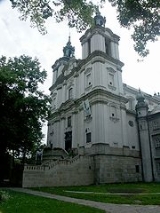
Skalka
Encyclopedia

Polish language
Polish is a language of the Lechitic subgroup of West Slavic languages, used throughout Poland and by Polish minorities in other countries...
, is a small hillock in Kraków
Kraków
Kraków also Krakow, or Cracow , is the second largest and one of the oldest cities in Poland. Situated on the Vistula River in the Lesser Poland region, the city dates back to the 7th century. Kraków has traditionally been one of the leading centres of Polish academic, cultural, and artistic life...
where the Bishop of Kraków saint
Saint
A saint is a holy person. In various religions, saints are people who are believed to have exceptional holiness.In Christian usage, "saint" refers to any believer who is "in Christ", and in whom Christ dwells, whether in heaven or in earth...
Stanislaus of Szczepanów
Stanislaus of Szczepanów
Stanislaus of Szczepanów, or Stanisław Szczepanowski, was a Bishop of Kraków known chiefly for having been martyred by the Polish king Bolesław II the Bold...
was slain by order of Polish king Bolesław II the Bold in 1079. This action resulted in the king's exile and the eventual canonization
Canonization
Canonization is the act by which a Christian church declares a deceased person to be a saint, upon which declaration the person is included in the canon, or list, of recognized saints. Originally, individuals were recognized as saints without any formal process...
of the slain bishop.
Originally, a Romanesque
Romanesque architecture
Romanesque architecture is an architectural style of Medieval Europe characterised by semi-circular arches. There is no consensus for the beginning date of the Romanesque architecture, with proposals ranging from the 6th to the 10th century. It developed in the 12th century into the Gothic style,...
church was built there. King Casimir III
Casimir III of Poland
Casimir III the Great , last King of Poland from the Piast dynasty , was the son of King Władysław I the Elbow-high and Hedwig of Kalisz.-Biography:...
raised a new gothic
Gothic architecture
Gothic architecture is a style of architecture that flourished during the high and late medieval period. It evolved from Romanesque architecture and was succeeded by Renaissance architecture....
church in its place and since 1472 this shrine has been in the possession of a monastic community of Pauline Fathers. In 1733-1751 the church received a baroque
Baroque
The Baroque is a period and the style that used exaggerated motion and clear, easily interpreted detail to produce drama, tension, exuberance, and grandeur in sculpture, painting, literature, dance, and music...
decor. It is one of the most famous Polish sanctuaries.
The crypt underneath the church serves as a "national Panthéon
Panthéon, Paris
The Panthéon is a building in the Latin Quarter in Paris. It was originally built as a church dedicated to St. Genevieve and to house the reliquary châsse containing her relics but, after many changes, now functions as a secular mausoleum containing the remains of distinguished French citizens...
", a burial place for some of the most distinguished Poles, particularly those who lived in Kraków.
- Jan Długosz (1415–1480), diplomat and historian
- Wincenty PolWincenty PolWincenty Pol was a Polish poet and geographer.-Life:Pol was born in Lublin , to Franz Pohl , a German in the Austrian service, and his wife Eleonora Longchamps de Berier, from a French family living in Poland. Pol fought in the Polish army in the November 1830 Uprising and participated in the 1848...
(1807–1872), poet, geographer and freedom fighter - Lucjan SiemieńskiLucjan SiemienskiLucjan Siemieński was a Polish Romantic poet, prose writer, and literary critic.-External links:*...
(1809–1877), poet, writer and freedom fighter - Józef Ignacy KraszewskiJózef Ignacy KraszewskiJózef Ignacy Kraszewski was a Polish writer, historian and journalist who produced more than 200 novels and 150 novellas, short stories, and art reviews He is best known for his epic series on the history of Poland, comprising twenty-nine novels in seventy-nine parts.As a novelist writing about...
(1812–1887), writer and historian - Teofil LenartowiczTeofil LenartowiczTeofil Aleksander Lenartowicz was a Polish ethnographer, sculptor, poet and Romantic conspirator...
(1822–1893), poet and sculptor - Adam AsnykAdam AsnykAdam Asnyk , was a Polish poet and dramatist. Born September 11, 1838 in Kalisz to a szlachta family, he was educated for an heir of his family's estate. As such he received education at the Institute of Agriculture and Forestry in Marymont and then the Medical Surgeon School in Warsaw. He...
(1838–1897), poet, playwright and freedom fighter - Henryk SiemiradzkiHenryk SiemiradzkiHenryk Siemiradzki was a Polish 19th century painter active in the period of foreign Partitions of Poland, and best remembered for his monumental Academic art...
(1843–1902), painter - Stanisław Wyspiański (1869–1907) poet, playwright and painter
- Jacek MalczewskiJacek MalczewskiJacek Malczewski was one of the most famous painters of Polish Symbolism. In his creativity he successfully joins the predominant style of his times with motifs of Polish martyrdom.-See also:...
(1854–1929), painter - Karol SzymanowskiKarol SzymanowskiKarol Maciej Szymanowski was a Polish composer and pianist.-Life:Szymanowski was born into a wealthy land-owning Polish gentry family in Tymoszówka, then in the Russian Empire, now in Cherkasy Oblast, Ukraine. He studied music privately with his father before going to Gustav Neuhaus'...
(1882–1937), composer and pianist - Ludwik SolskiLudwik SolskiLudwik Solski , born Ludwik Napoleon Karol Sosnowski,was a Polish stage actor and theatre director. From his stage debut in 1876 until his death he played in nearly a thousand roles.Between 1905 and 1913 he was the director-general of the municipal theatre in Cracow...
(1855–1954), theatre actor and director - Tadeusz BanachiewiczTadeusz BanachiewiczTadeusz Banachiewicz was a Polish astronomer, mathematician and geodesist....
(1882–1954), astronomer and mathematician - Czesław Miłosz (1911–2004), poet and essayist, Nobel Prize recipient
Trivia
- There are currently no women buried among the distinguished Poles.
- As of 2007, there was room for two or three more tombs in the crypt.
- Długosz, Siemieński, Pol and Banachiewicz were originally buried elsewhere.

